If you sometimes feel a bit intimated by the menu at your local steakhouse, you’re not alone. With dozens of different steak cuts, each with two or three different names, it can be hard to keep them all straight. Since they all have different flavors, levels of tenderness, and prices, it’s not surprising that most people just go with the same thing time after time.
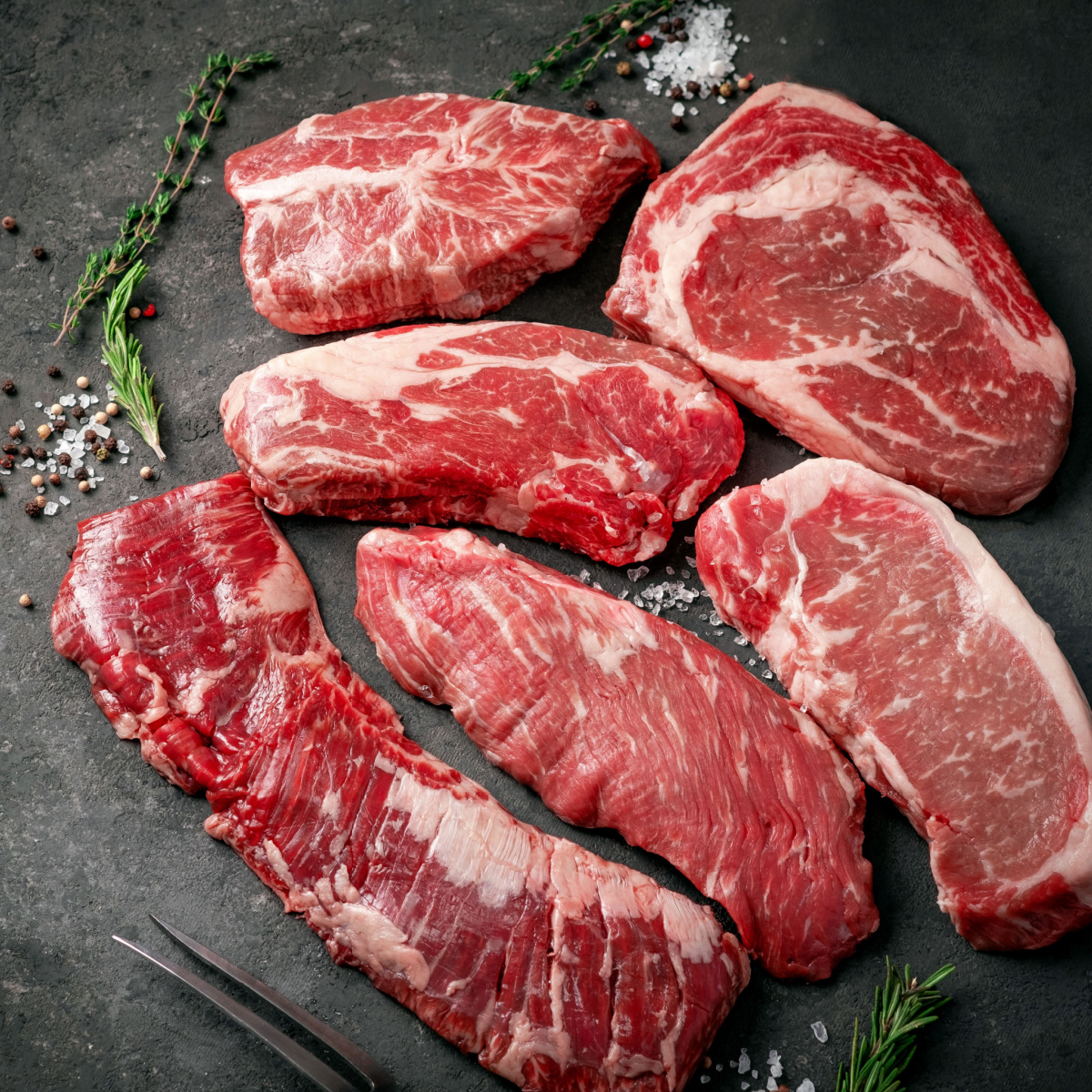
Whether you’re looking to become a beef expert or just want to learn one or two cuts you like best, it’s time to get your degree in butchery. Below, you can find a breakdown of any cut of beef you’re likely to find, complete with information on appearance, flavor, tenderness, cost, and more.
Table of Contents
Ribeye Steak
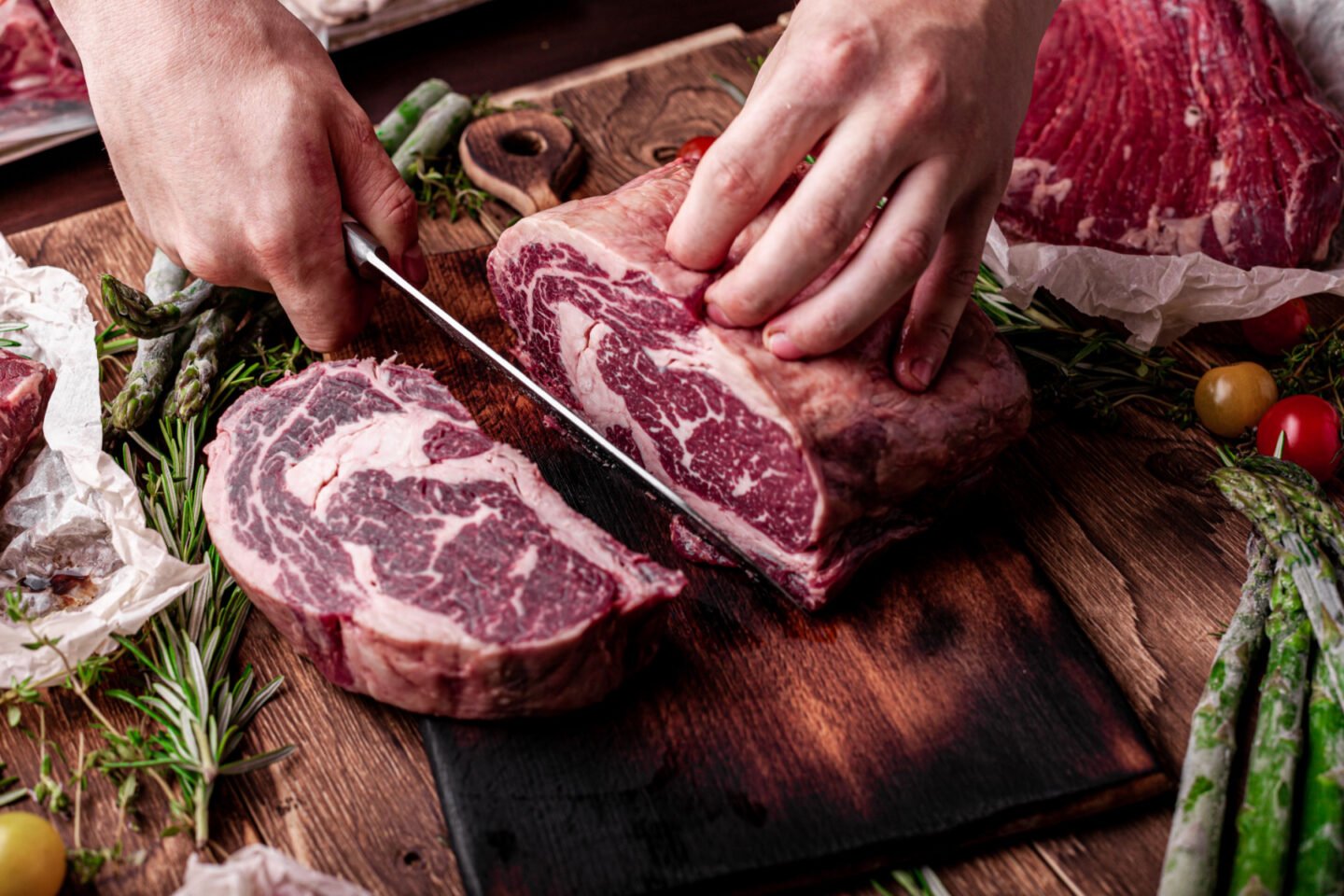
Different names: Cowboy steak, tomahawk steak, Spencer steak, Delmonico steak
Appearance: Well-marbled with several large streaks of fat
Flavor: Rich and buttery
Tenderness: Medium
Cost: $15.84 per pound
Primal Cut: Rib
The ribeye steak is prized for its excellent fat marbling, which gives it a rich flavor and tender texture. While a ribeye might not be quite as tender as a tenderloin steak, many find that it has just the right amount of chew and texture. Just keep in mind that it is fatty, so it isn’t the most healthy option when compared to other cuts.
Ribeyes are also a good choice for cooking at home, as their high-fat content makes them resistant to drying out.
Tenderloin Steak
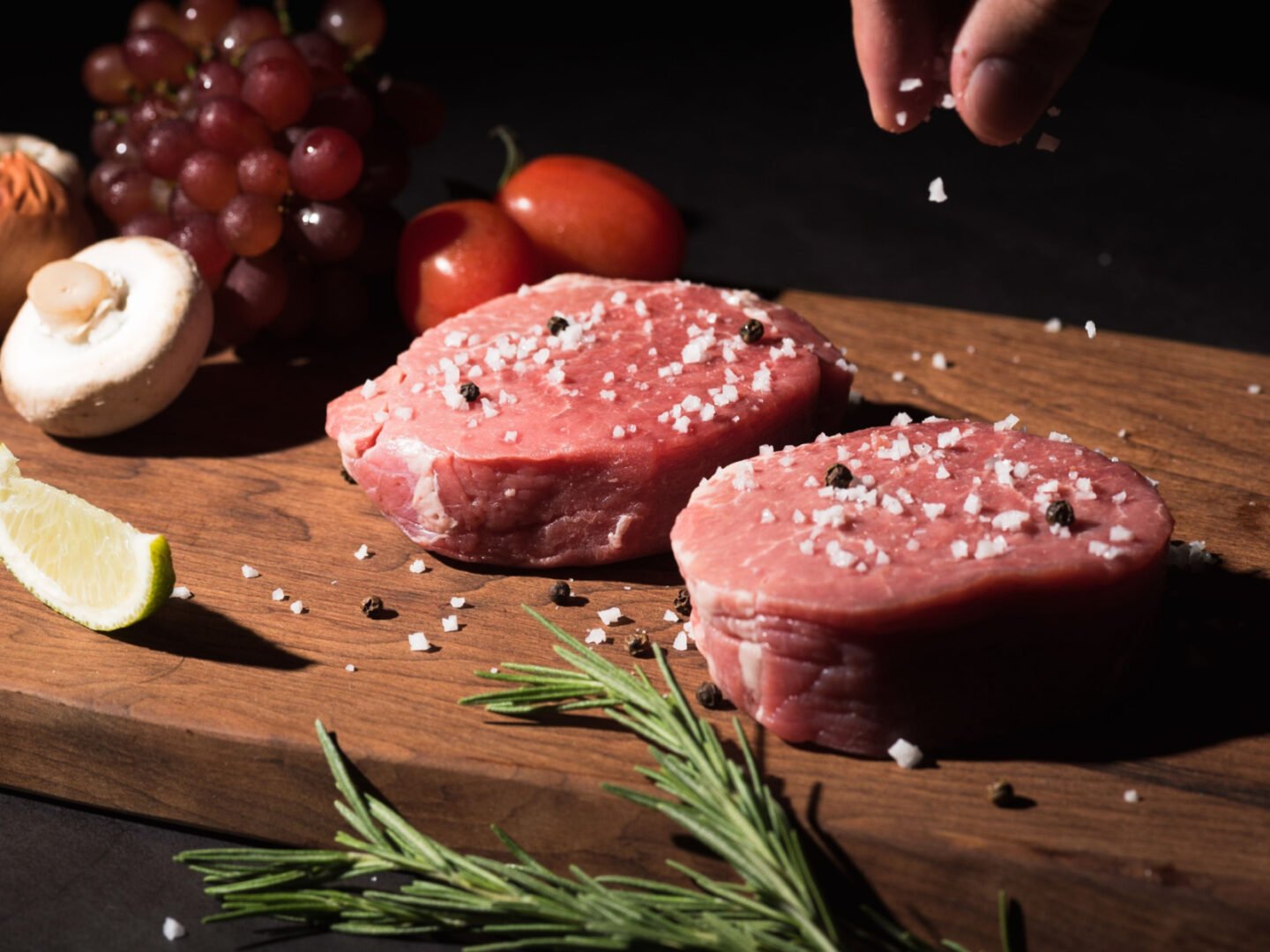
Different names: Filet Mignon, beef tenderloin, filet de boeuf, tender steak
Appearance: Round, compact, and with minimal marbling
Flavor: Lean, mild, and slightly sweet
Tenderness: Very tender
Cost: $14.16 per pound
Primal Cut: Loin
When you’re going for luxury, the tenderloin steak may be the most popular option. Commonly known as the filet mignon, it is the most tender of all cuts of beef, making it a joy to cut and chew. It doesn’t have as robust a flavor as a ribeye or New York strip, though with the right care, it can make a delicious meal. The tenderloin steak is versatile, but care needs to be taken to keep it juicy.
Strip Steak
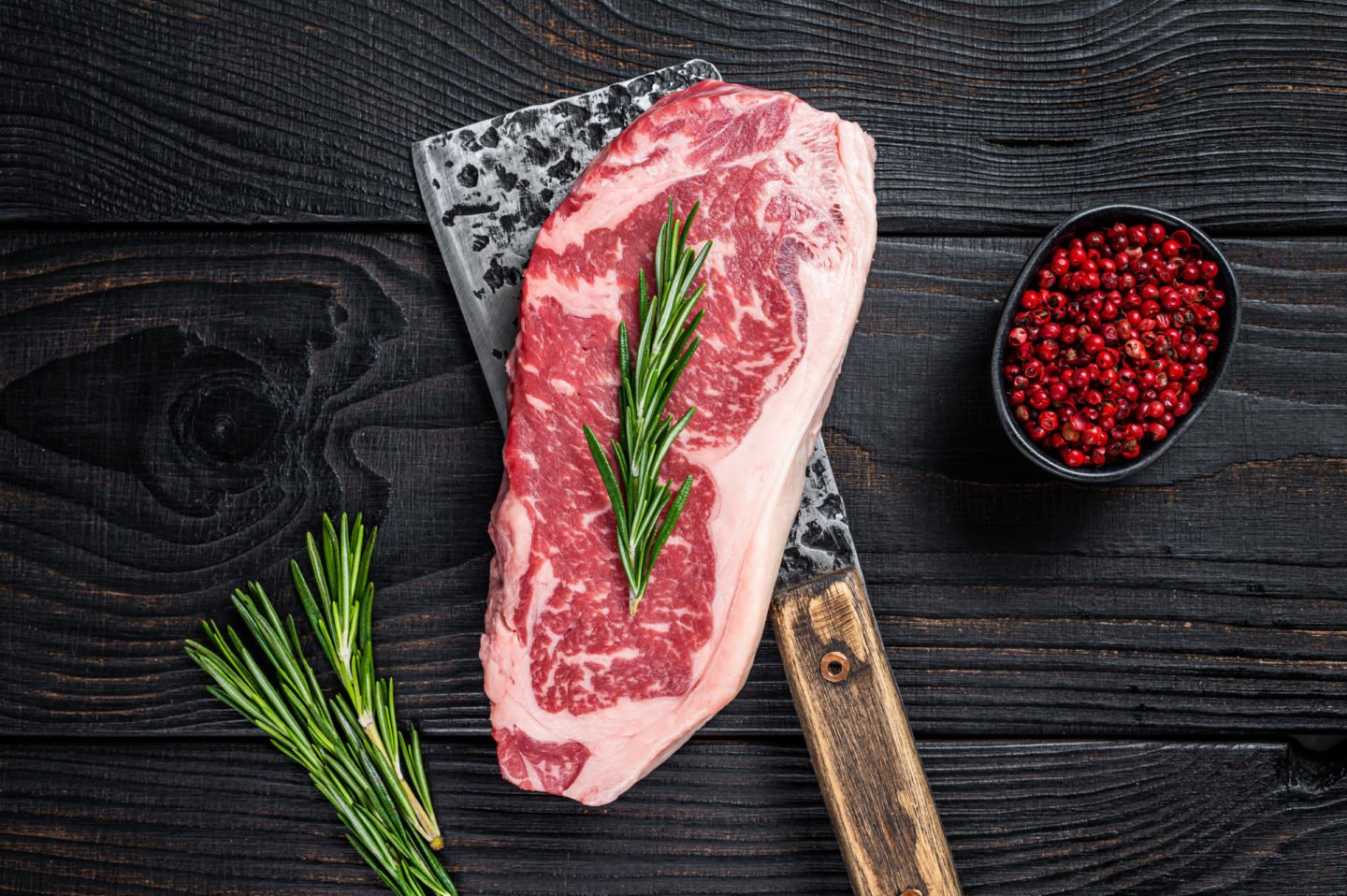
Different names: New York Strip, Kansas City Strip, top sirloin steak
Appearance: Elongated shape with a strip of fat down one side
Flavor: Intense flavor with a bold, beefy taste
Tenderness: Tender but firm
Cost: $9.44 per pound
Primal Cut: Loin
The classic strip steak is a good people-pleaser that offers a balance between big flavor and a tender texture. This also makes it versatile for cooking, with enough fat to keep it juicy. The large strip of fat running down the side renders while it cooks, lending rich flavor to the steak.
The strip steak goes by a few different names, and each one is slightly different. The two most common are the New York Strip and the Kansas City Strip. The first is served boneless, while the latter is served with a bone.
Hanger Steak
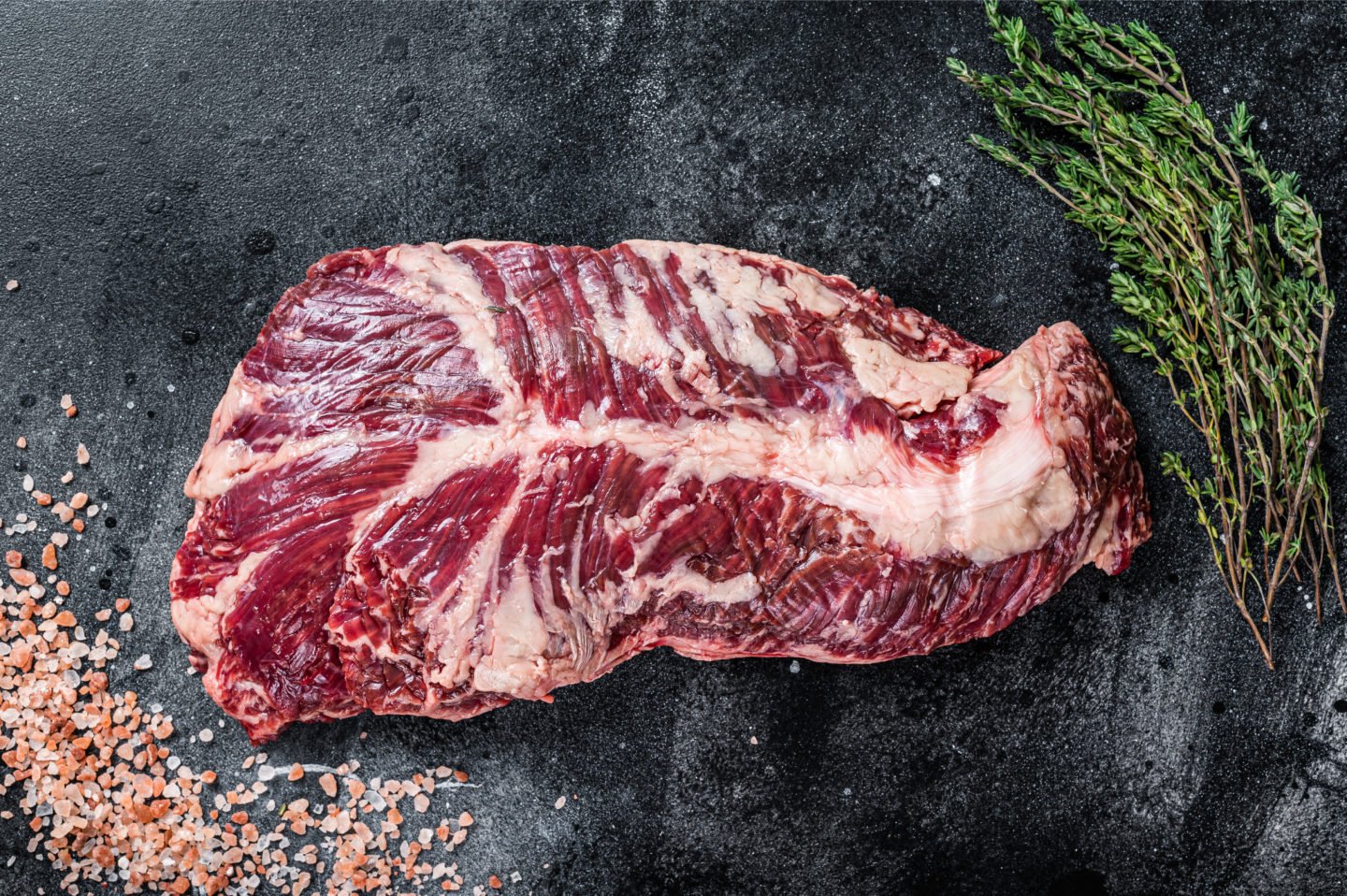
Different names: Butcher’s steak, hanging tender, Onglet
Appearance: Elongated and sinewy
Flavor: Rich and savory with a hint of iron
Tenderness: Medium-tender
Cost: $8.83 per pound
Primal Cut: Loin
This steak gets its nickname butcher’s steak because it was once the hidden gem of beef experts. It’s not quite as luxurious as the ribeye or strip, though it has a surprisingly deep flavor and tender texture. Just be careful, as the hanger steak is covered in a tough sinew, which needs to be removed by an expert butcher.
While hanger steaks used to be one of the cheaper cuts, they have increased in popularity, impacting their price.
T-Bone Steak
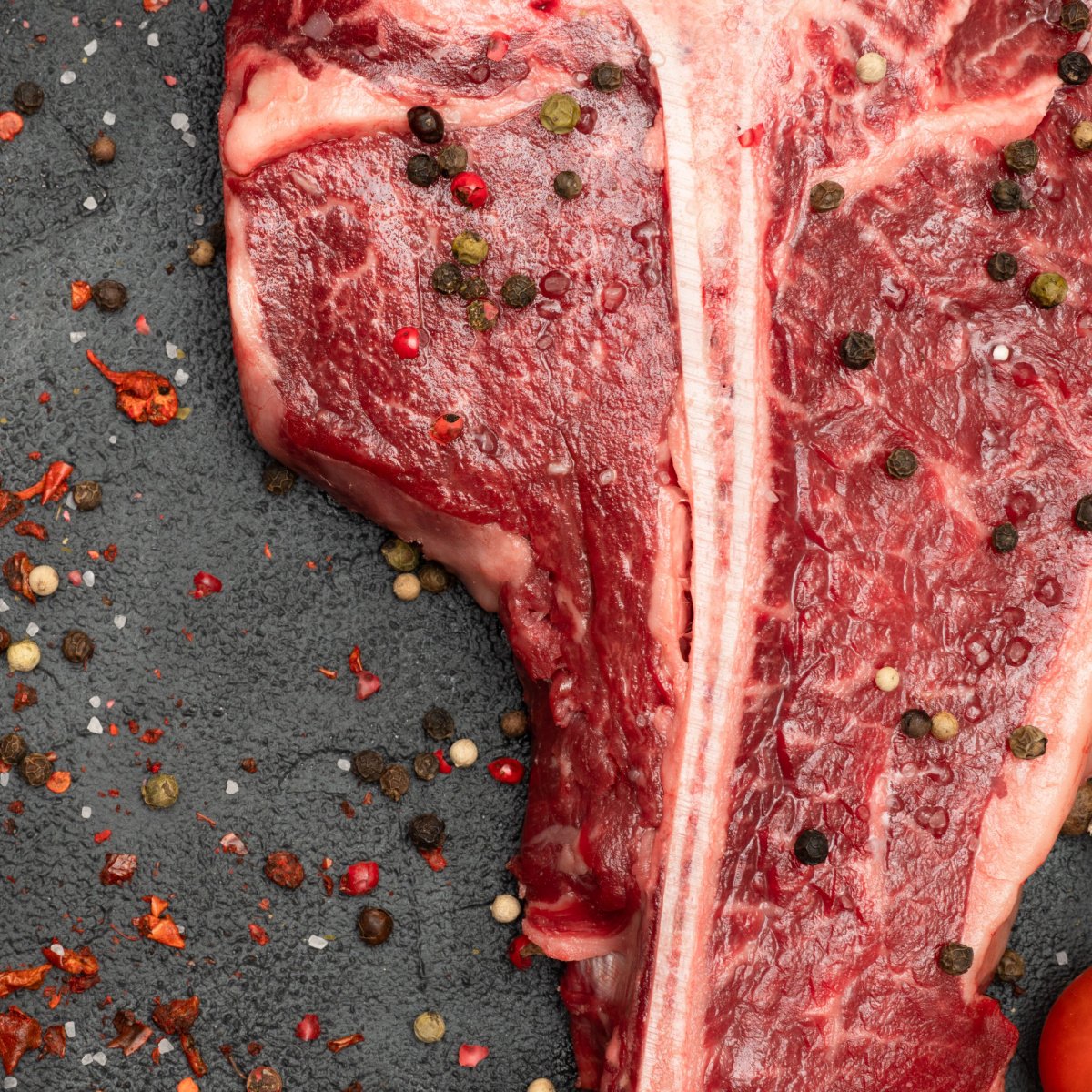
Different names: Porterhouse
Appearance: A large cut with a T-shaped bone in the middle
Flavor: Rich and beefy on one side, lean on the other
Tenderness:Very tender to medium tender
Cost: $9.99 per pound
Primal Cut: Loin
A T-bone is actually two steaks in one, specifically a strip and a tenderloin separated by a T-shaped bone in the middle. It’s often shared by couples, or eaten alone by those with hearty appetites.
Remember that T-bone steaks can be challenging to cook since each side of the steak has its own needs. The bone in the middle also makes it difficult to sear in a pan, so you may be better off cooking it on the grill.
Porterhouse
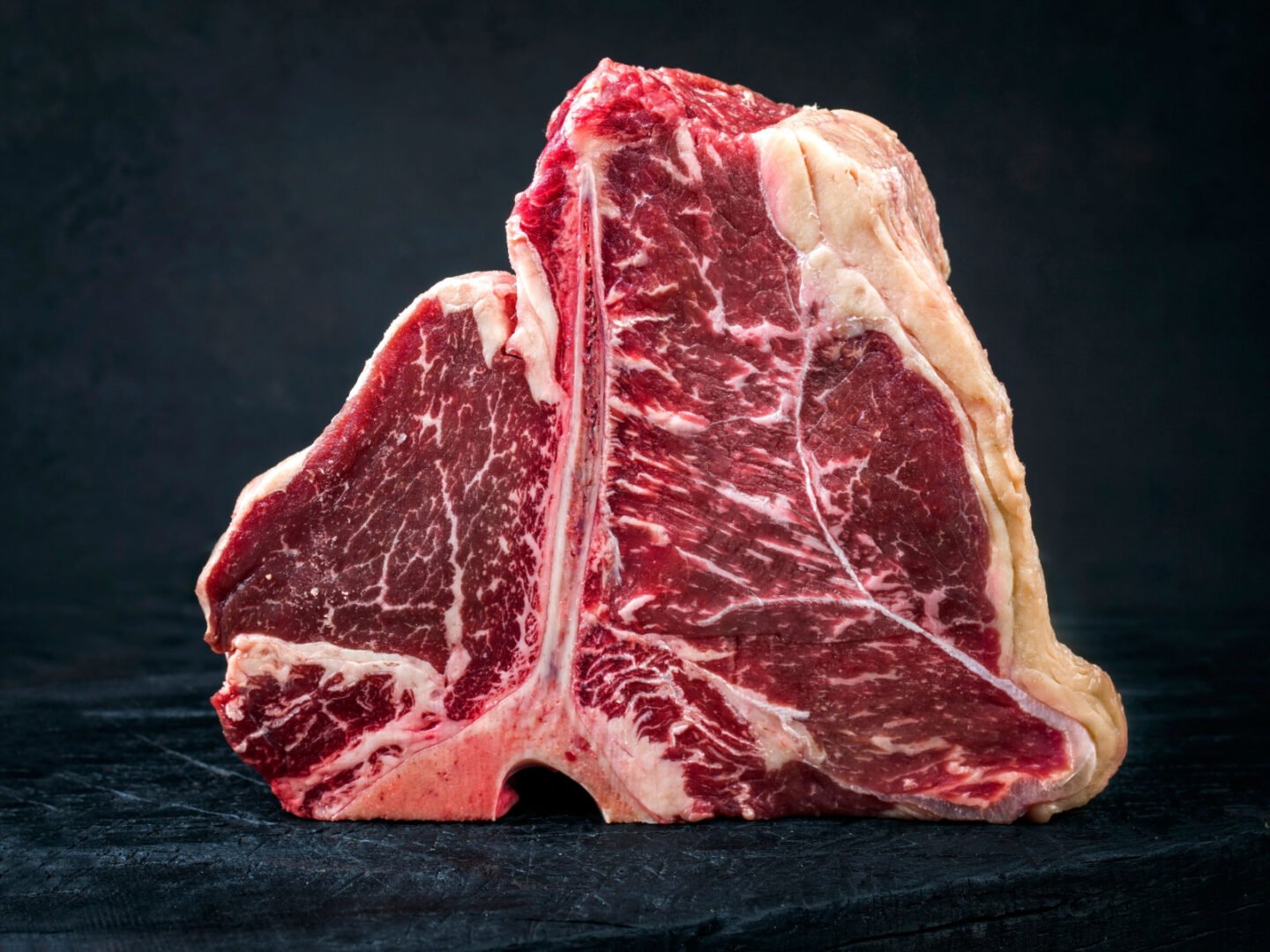
Different names: T-bone steak, New York Strip
Appearance: A large cut with a T-shaped bone in the center
Flavor: Rich and beefy on one side, lean on the other
Tenderness: Very tender to medium tender
Cost: $9.99 per pound
Primal Cut: Loin
Porterhouse steaks and T-bone steaks are actually the same cut of meat with one crucial difference. Porterhouse steaks are at least 1.25 inches thick, while any other steak is just a regular T-bone.
Either way, they’re both delicious, though the porterhouse is the ideal choice if you want a T-bone to serve a big appetite (or two).
Flank Steak
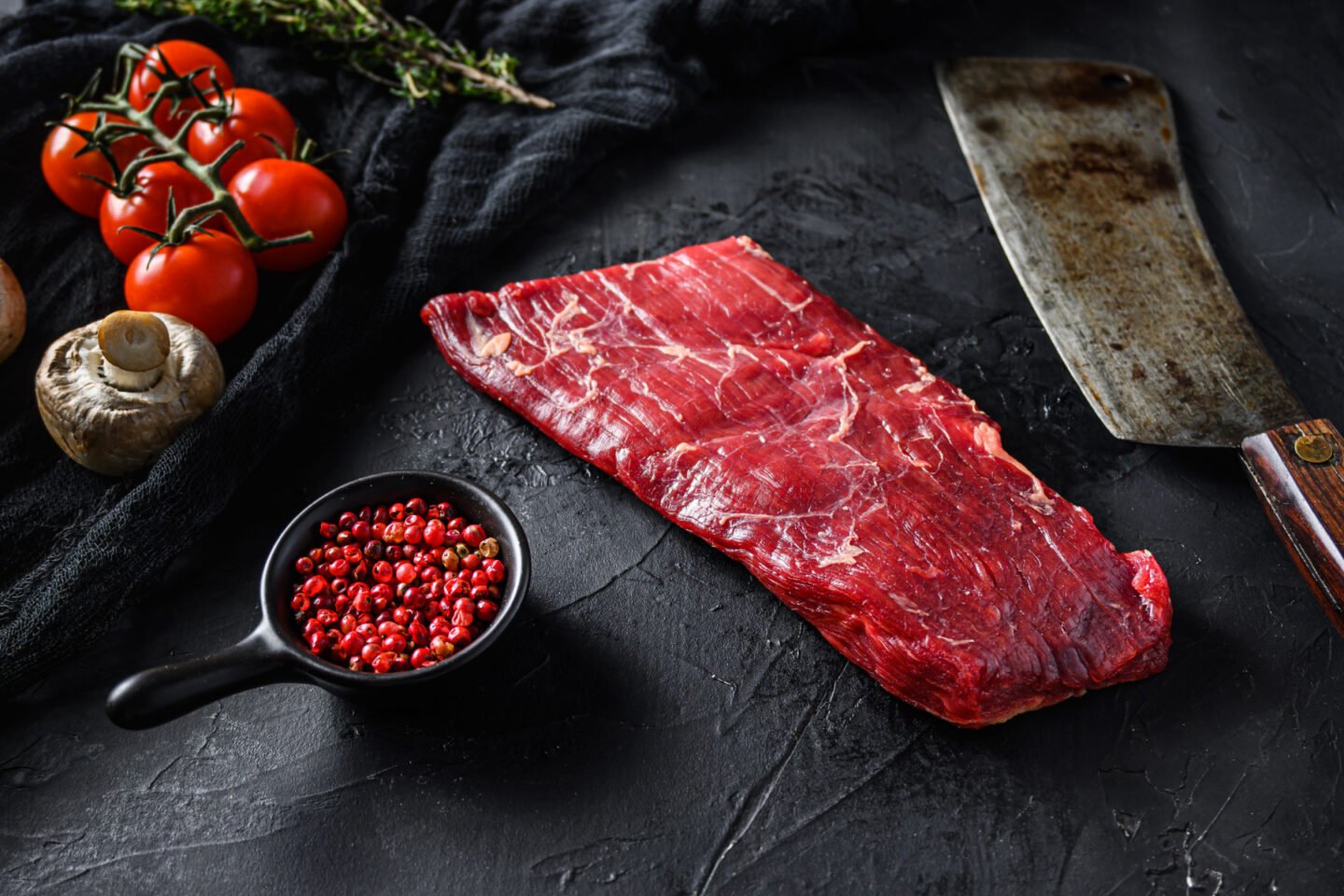
Different names: Philadelphia steak, fajita steak
Appearance: Long and sinewy, often cut into strips
Flavor: Lean, with a strong beef flavor
Tenderness: Chewy and sinewy
Cost: $9.46 per pound
Primal Cut: Flank
The flank steak comes from a part of the cow that gets a regular workout, which is what makes the meat chewier. While it definitely isn’t the most tender cut of beef, the right preparation can make it perfectly tender. The key is cutting it against the grain into strips, which is what makes it so good for fajitas. Since the steaks are so thin, they’re best cooked over extremely high heat, to char the outside quickly.
Skirt Steak
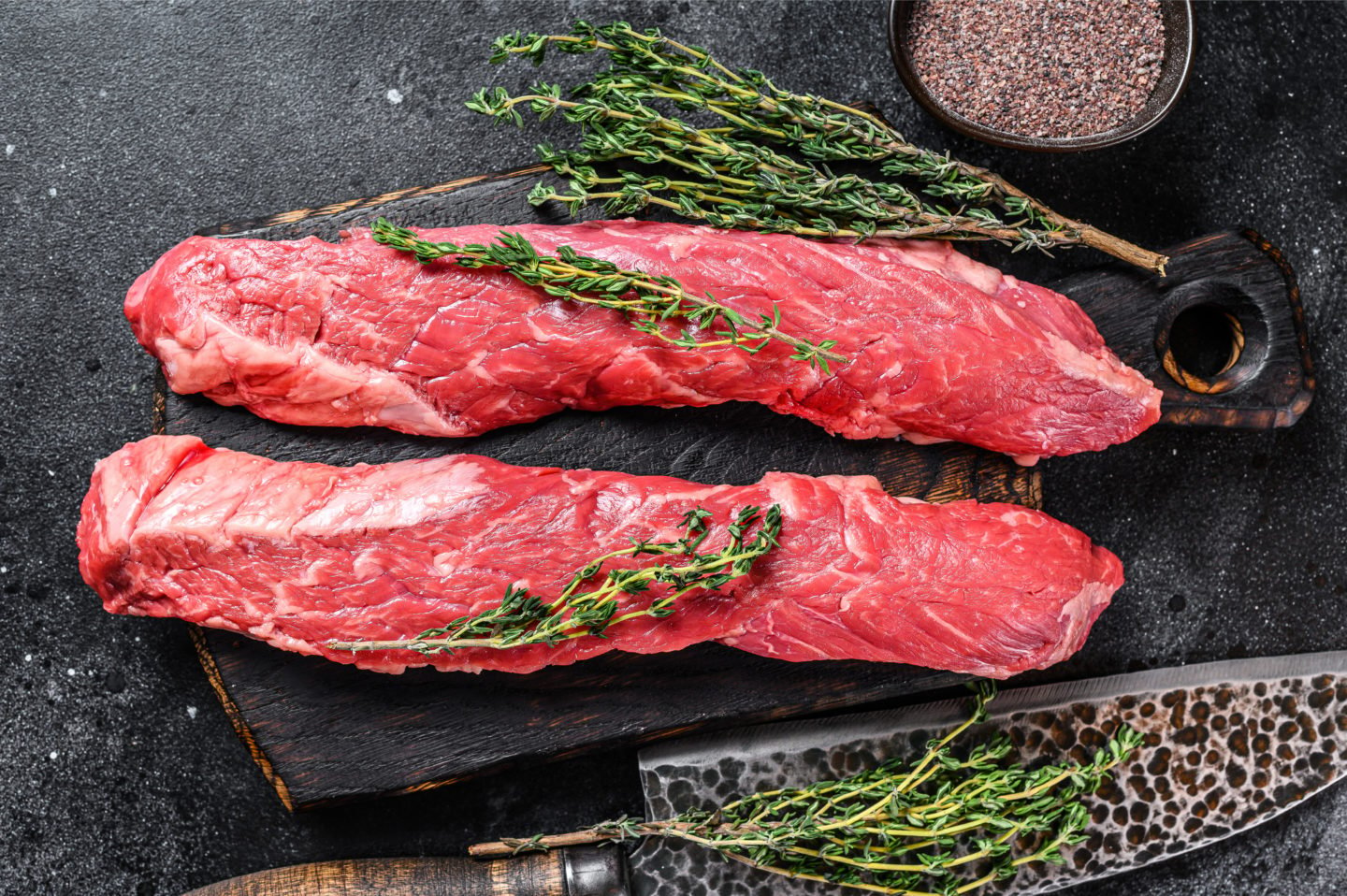
Different names: Romanian steak, Romanian tenderloin, Philadelphia steak, Arrachera
Appearance: Sinewy, elongated, and well-marbled with fat
Flavor: Rich, buttery, and beefy
Tenderness: Very tough
Cost: $7.00 per pound
Primal Cut: Short Plate
This is another cut of beef which requires expert preparation to enjoy properly. Skirt steak is filled with connective tissue, which makes it one of the toughest cuts of beef out there. Luckily, marinating, cooking it carefully, and slicing it against the grain makes it deliciously tender. What distinguishes it from flank steak is its high-fat content, which lends a rich buttery flavor.
Flat Iron Steak
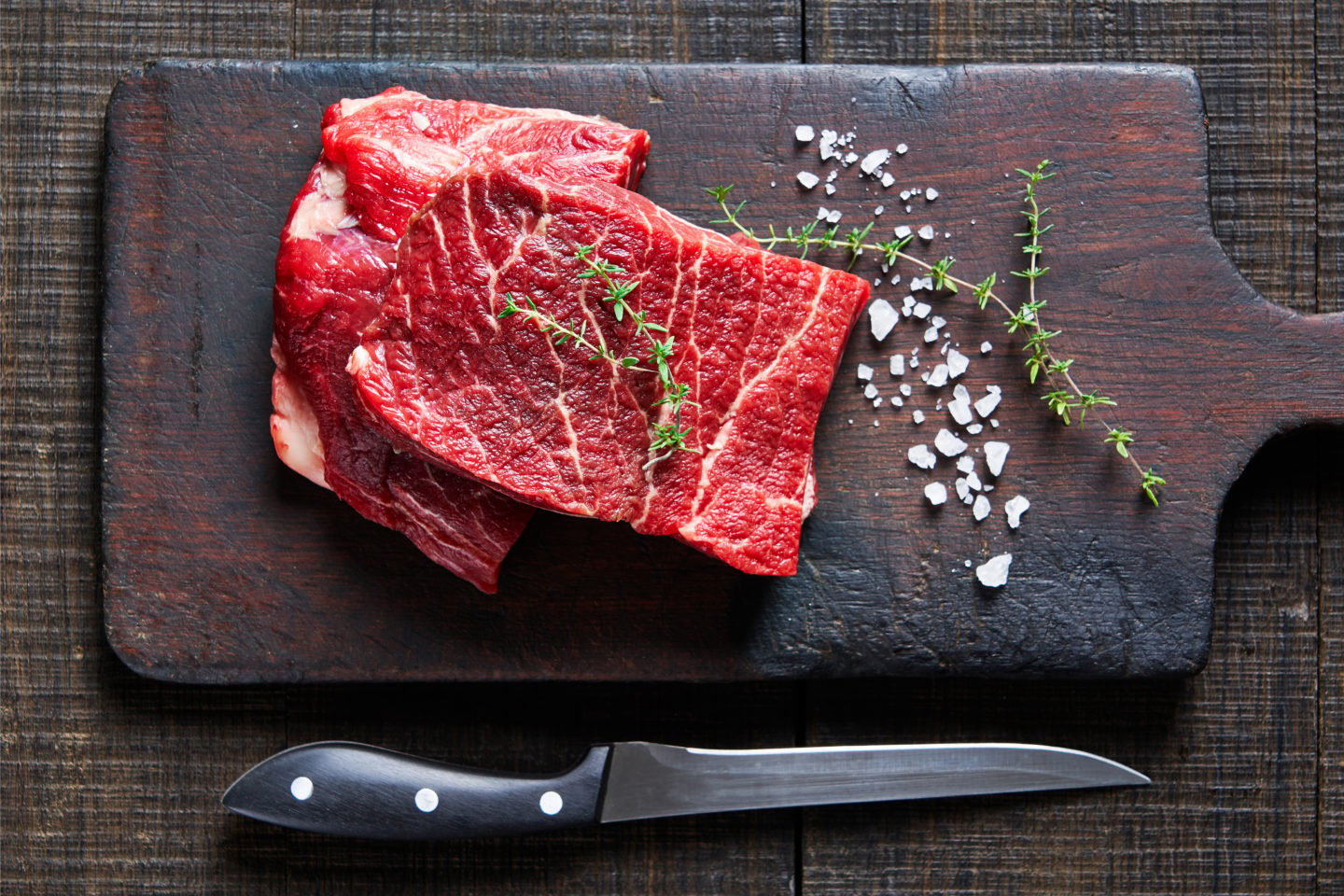
Different names: Butler’s steak, Oyster blade
Appearance: Rectangular shape and uniform thickness
Flavor: Rich and beefy, but benefits from a marinade
Tenderness: Tender, as long as the connective tissue is removed
Cost: $7.99 per pound
Primal Cut: Chuck
This is a relatively new cut of steak that used to be known as the butler’s steak, as it was often considered less desirable. While it isn’t as luxurious as some other cuts, a trained butcher will be able to make it the star of any meal. The key is removing the connective tissue, which will make it one of the most tender cuts. It brings plenty of flavor of its own, though it often needs a marinade to put it on par with more popular cuts.
Short Ribs
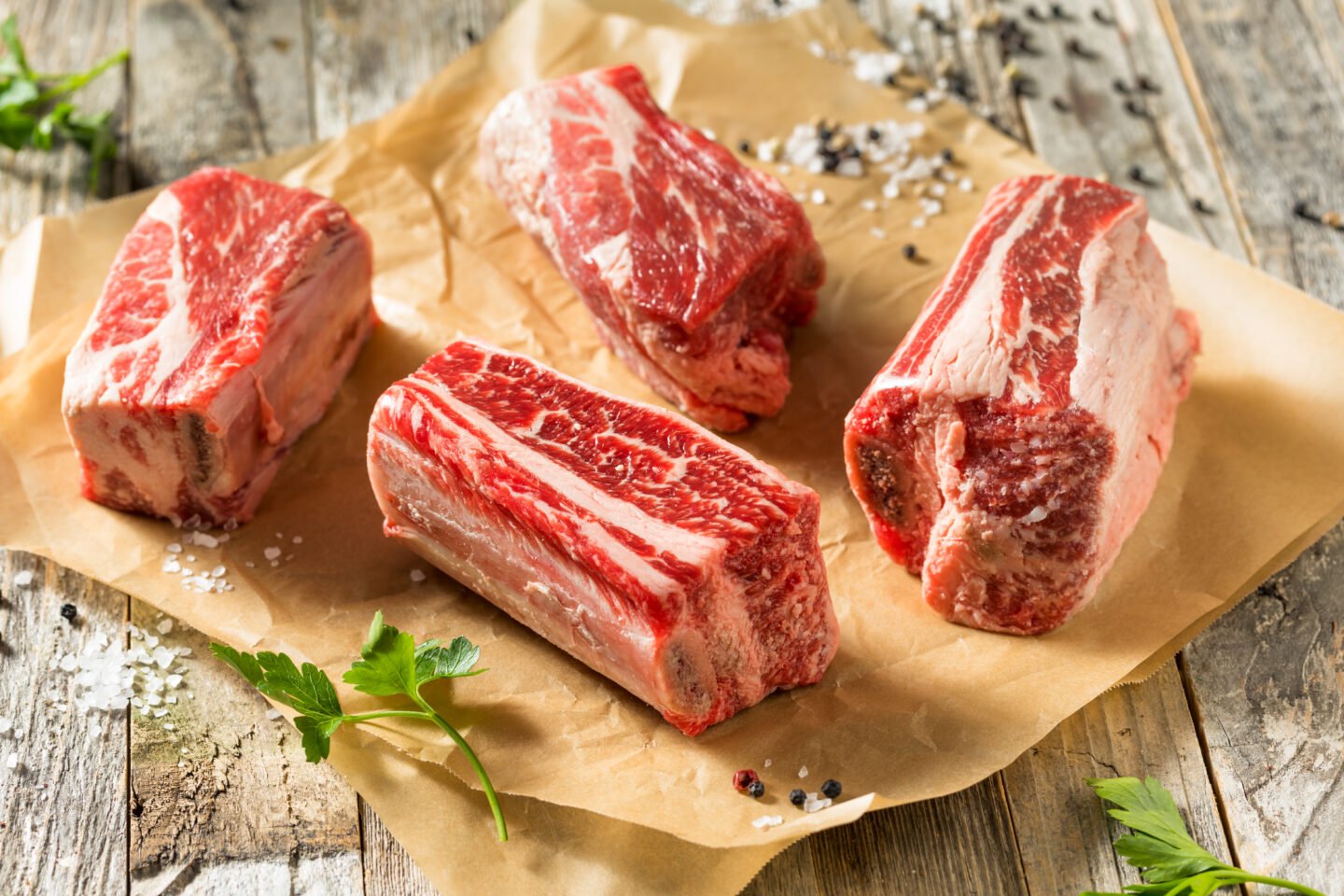
Different names: barbecue ribs, braising ribs, or fancy cut ribs
Appearance: Small squares of meat with a single bone
Flavor: Deep, beefy flavor similar to chuck roast
Tenderness: Juicy, silken texture
Cost: $5.76 per pound
Primal Cut: Short Plate
If you’re looking for something with the same depth of flavor as ribeye but with a slight twist, go with short ribs. They have excellent marbling, giving them a rich flavor and juicy bite that is difficult to dry out even under extreme heat. Braising is one of the most common cooking methods for this cut, though they’re versatile enough to cook on the grill or in the pan. You can also ask your butcher to remove the bone for you, if needed.
Sirloin Steak
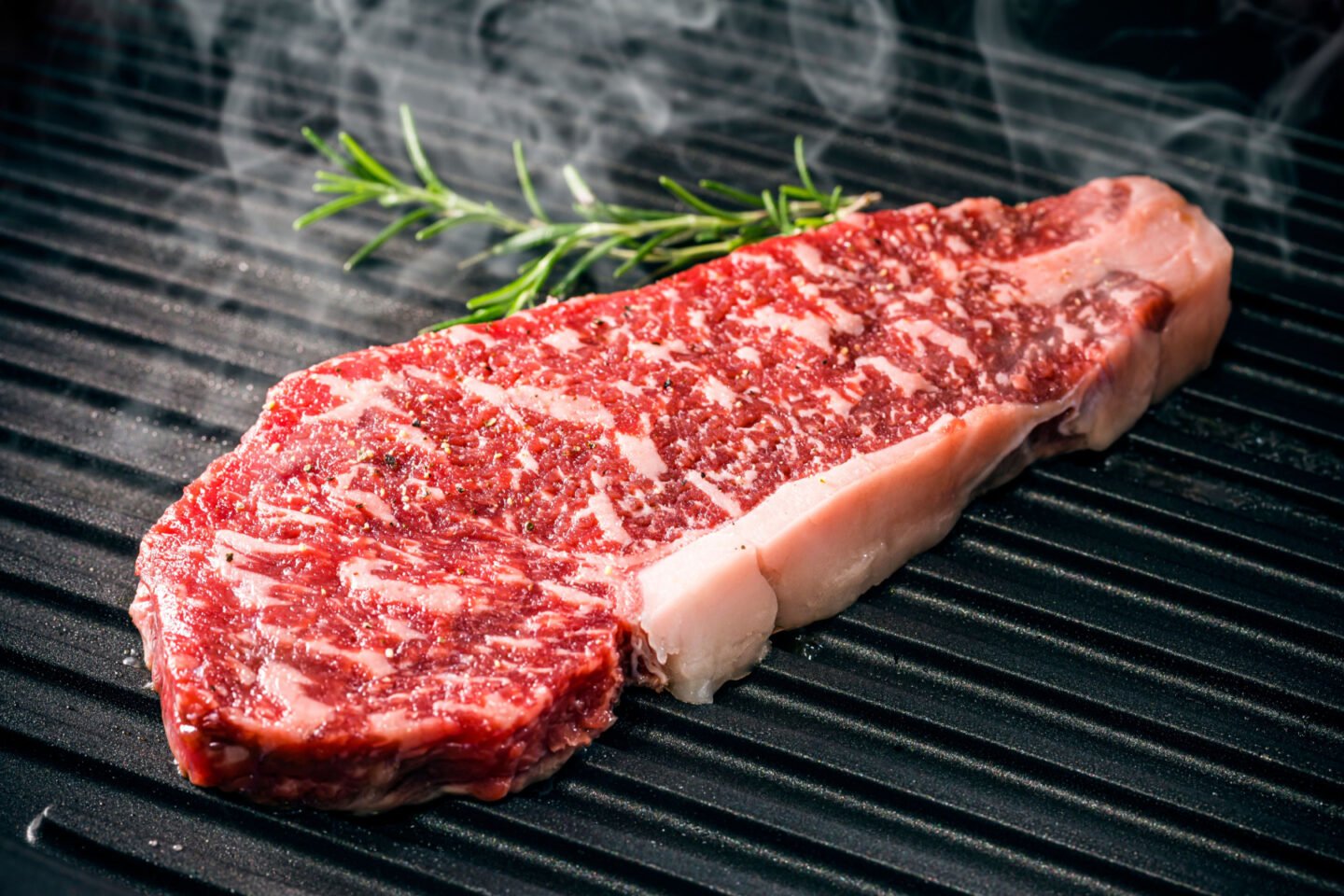
Different names: shell steak, Kansas City steak, sirloin steak
Appearance: Round, medium-sized cut with little marbling
Flavor: Lean with a middling depth of flavor
Tenderness: Medium tender with some chew
Cost: $6.30 per pound
Primal Cut: Loin
The sirloin steak is a jack-of-all-trades cut that balances a medium-tender texture with a lean flavor. While it doesn’t have the depth of the ribeye or tenderness of its close cousin the filet mignon, it’s a comparatively healthier and less expensive option. All of these qualities make it the perfect choice for a weekday meal. Just make sure to cook it carefully, as its lower fat content can dry it out if you’re not careful.
Tomahawk Steak
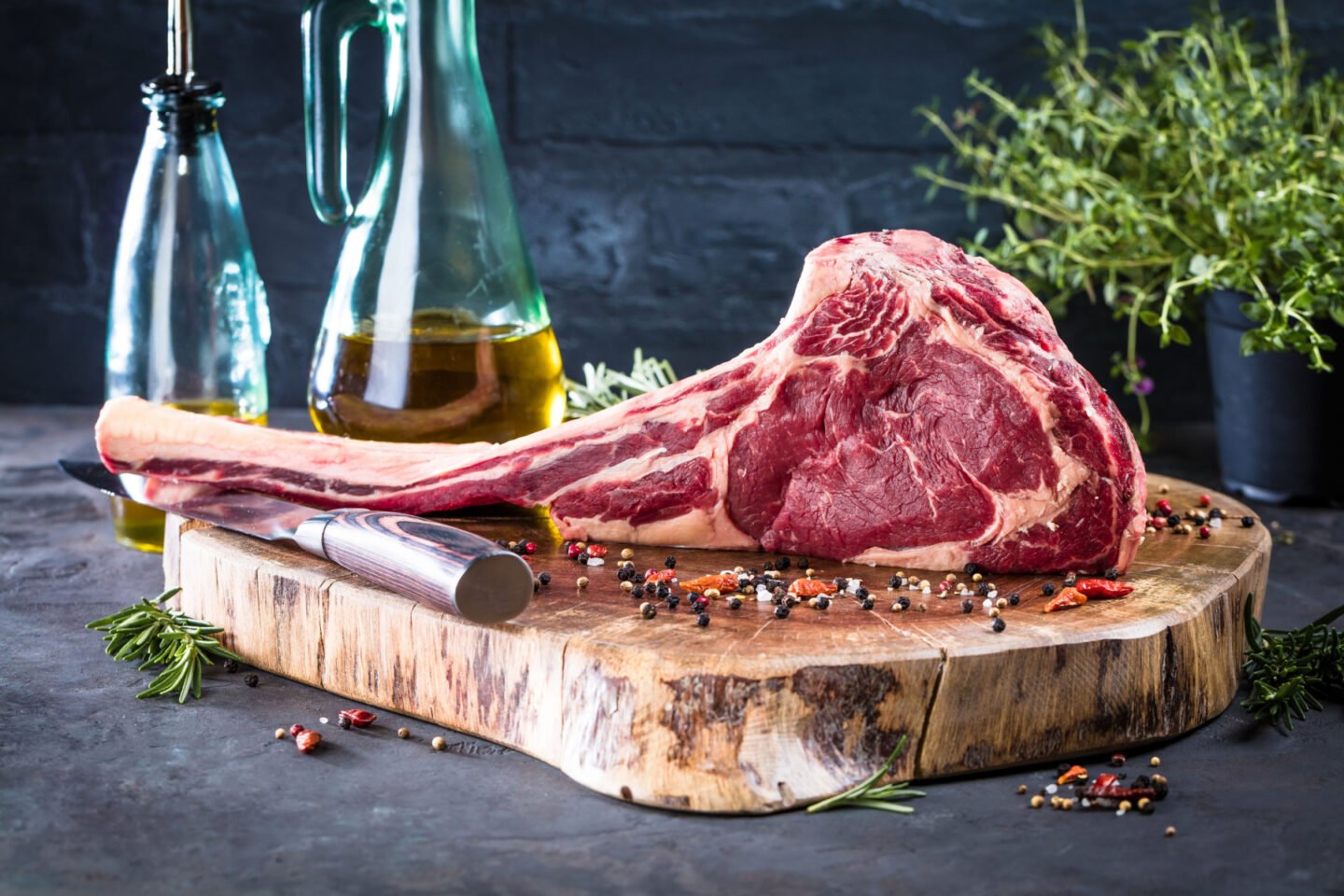
Different names: tomahawk chop, bone-in ribeye, and cote du boeuf
Appearance: just like a ribeye with a long bone coming off the end
Flavor: juicy, fatty, and luxuriously rich
Tenderness: highly tender
Cost: $9.92 per pound
Primal Cut: Rib
A tomahawk steak may sound exotic, but in reality, it’s only a ribeye with the bone left on. For the most part, the bone is just there for aesthetic purposes, though some believe it adds a bit of flavor when left on. If you’re cooking it at home, you can also save the bone to make a simple beef stock. No matter how you enjoy it, a tomahawk steak will be just as rich and delectable as any ribeye.
Flap steak
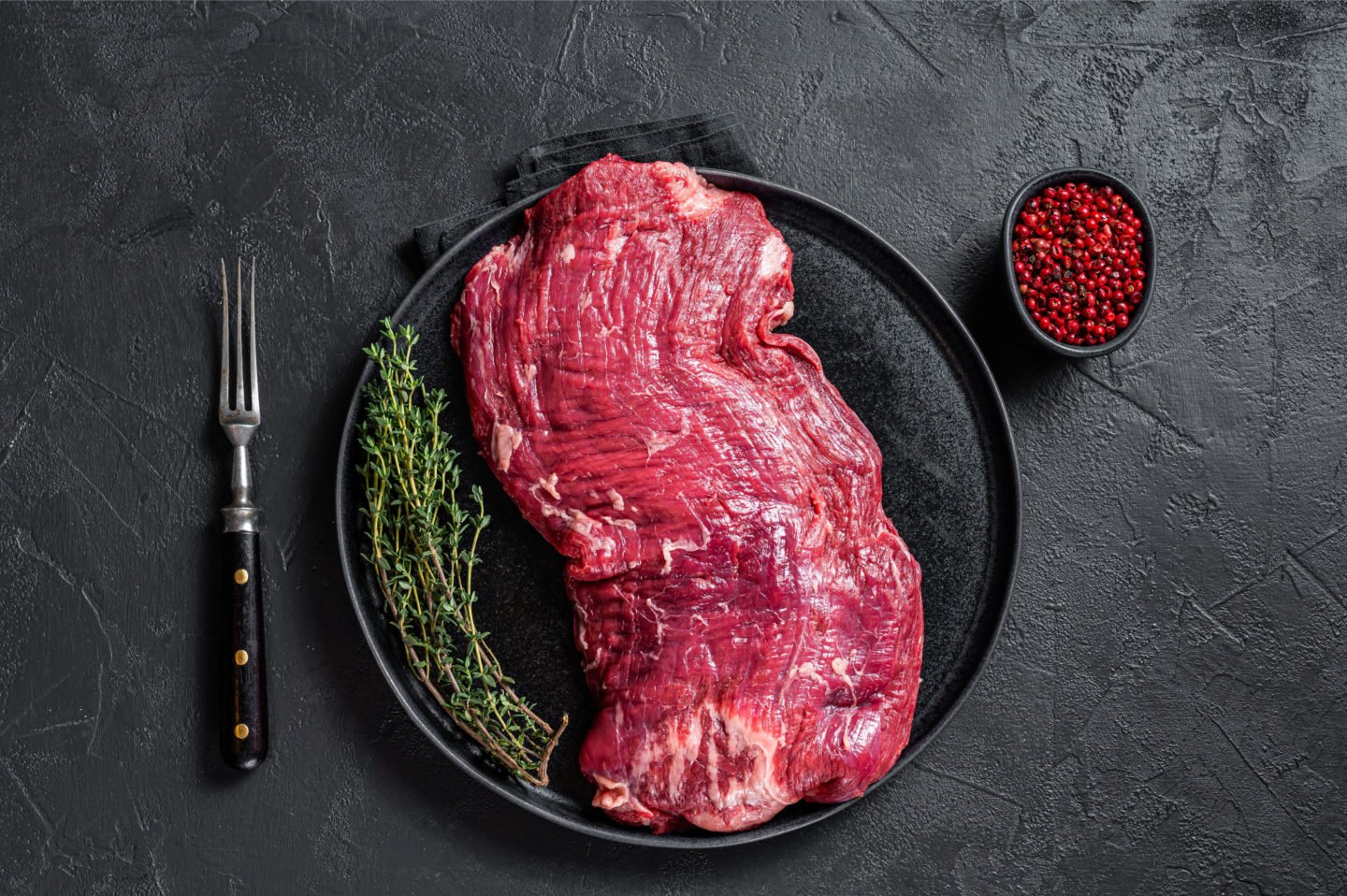
Different names: bottom sirloin butt
Appearance: A longer cut of meat with visible marbling all the way down
Appearance: Elongated with good marbling
Flavor: Sweet, minerally, and slightly buttery
Cost: $9.46 per pound
Primal Cut: Flank
Just like skirt steaks, flap steaks have a large, loose grain. This does mean they’re a bit tougher right off the grill, but it also helps them absorb marinades better than most other steaks. As long as you marinate and slice against the grain before serving, it will be pleasantly firm and easy to chew. You also want to grill them over high heat, so the outside can develop a nice char while the inside is perfectly medium-rate.
Tri-Tip Steak
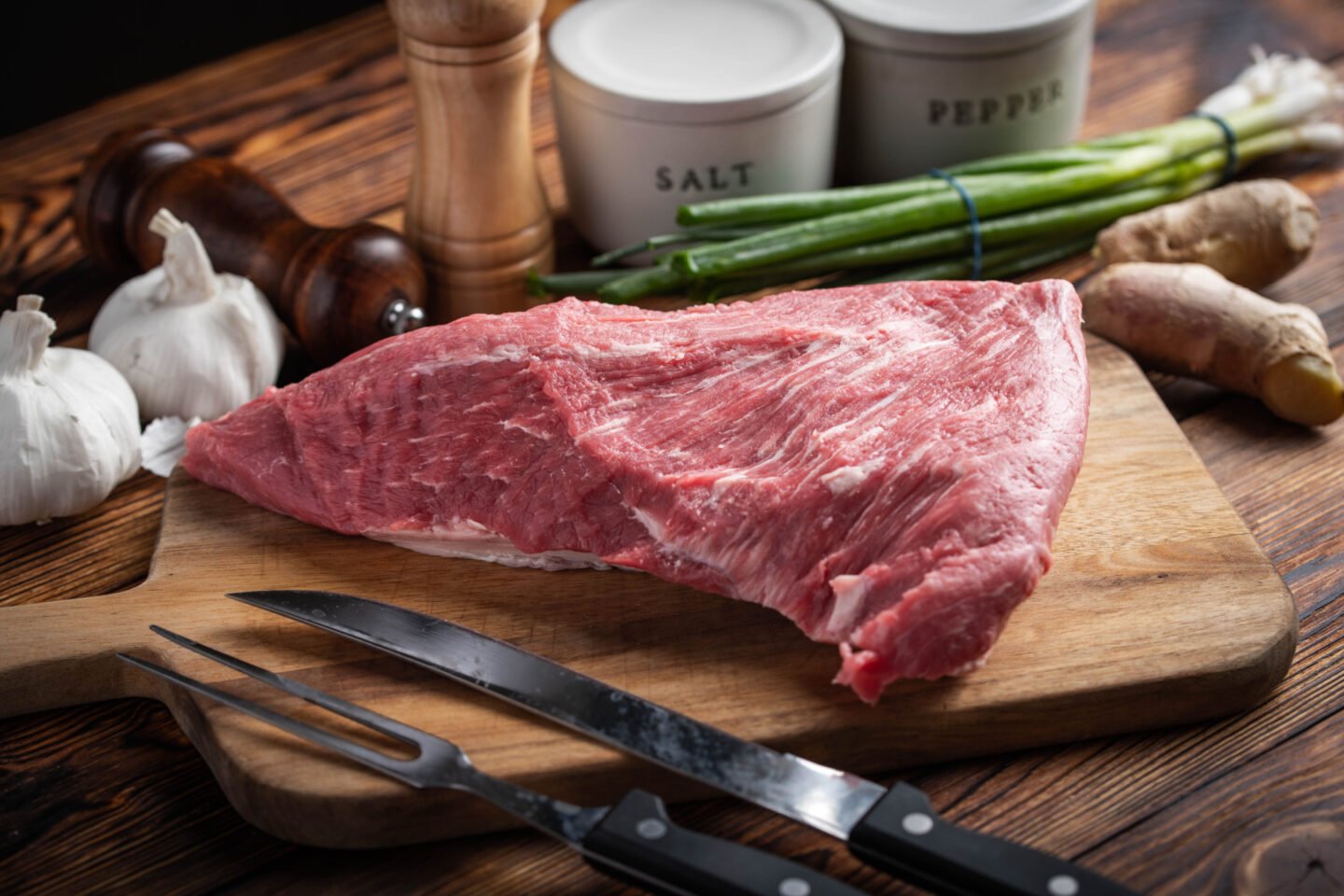
Different names: California cut, bottom sirloin butt, Newport steak, Santa Maria steak, poor man's brisket
Appearance: Triangular shape with plenty of marbling
Flavor: Rich and fatty
Tenderness: Highly tender with the right cooking
Cost: $6.16 per pound
Primal Cut: Loin
If you want a satisfying, deep flavor but don’t want to throw down the money for a ribeye or tenderloin steak, tri-tip is the way to go. It has just as much marbling as the ribeye and is perfectly suited to cooking on the grill. When preparing your own, make sure to cook it over high heat, but only for a short time, as this steak is best-enjoyed medium-rare. As long as it's cooked with care, it will be just as good as any luxury cut.
Rump Steak
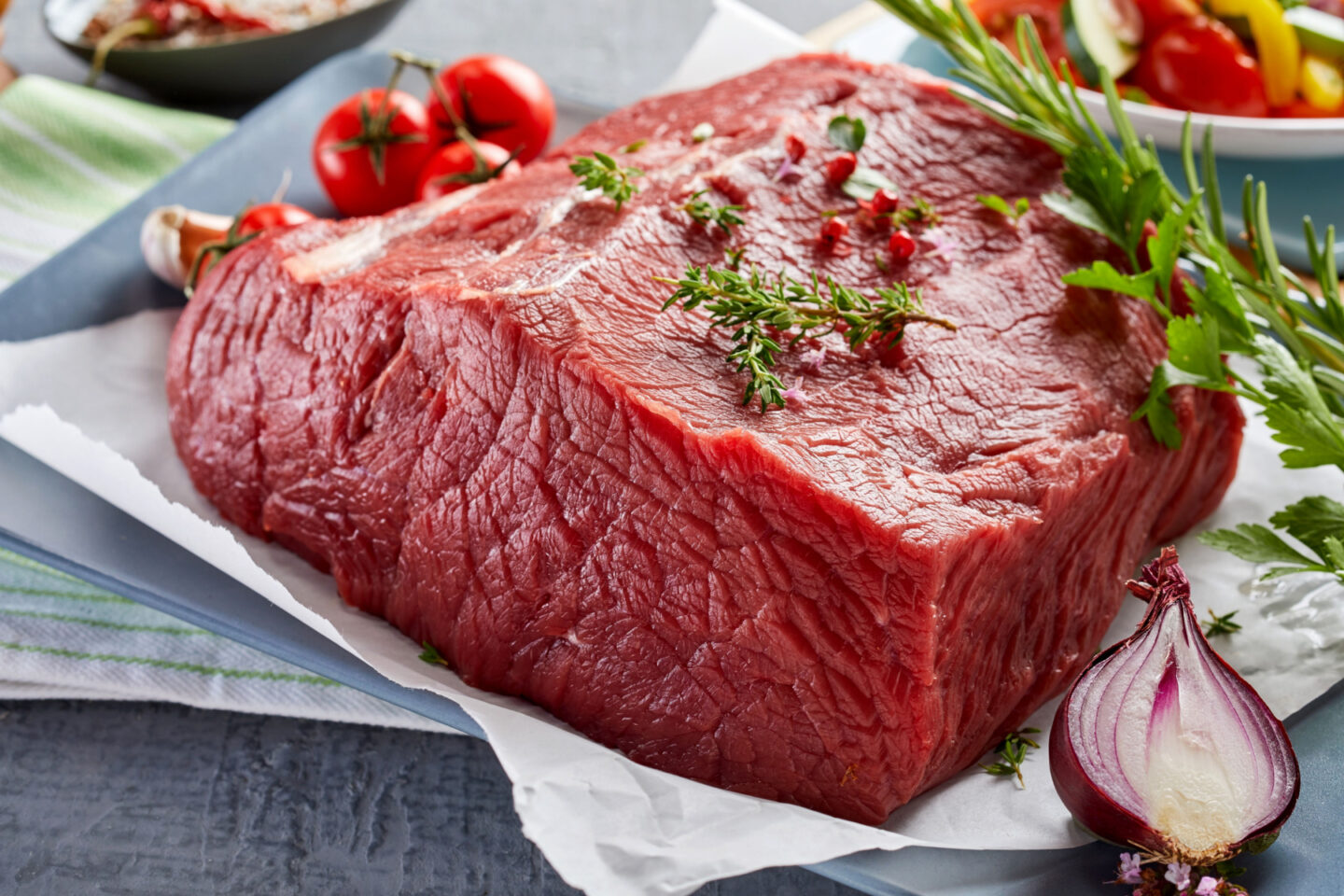
Different names: Round steak, bottom round
Appearance: A long and relatively lean cut of beef
Flavor: Lean and beefy
Tenderness: Moderately tough
Cost: $5.20 per pound
Primal Cut: Round
Rump steaks aren’t high-end cuts of beef, though as long as you know what you’re doing over the grill, they can be plenty tasty. The key is to marinate them for at least four or five hours before cooking. This will help balance the lean flavor and relatively tough texture. After they’re cooked, make sure they are allowed to rest, and then slice them against the grain for the best results.
Denver Steak
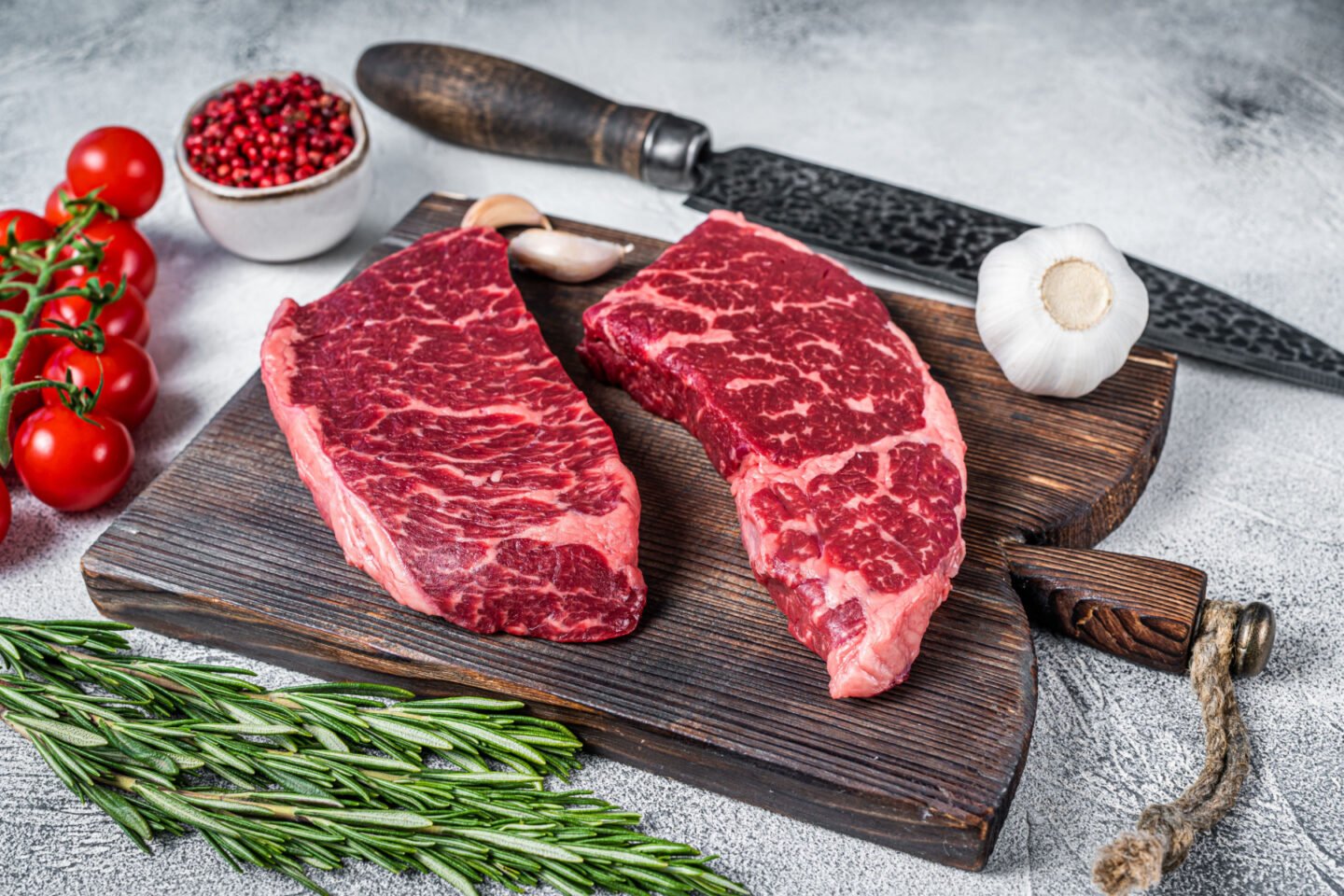
Different names: Denver cut, bottom chuck steak, underblade steak
Appearance: A squarish cut with visible marbling
Flavor: Rich and beefy
Tenderness: tender, with a wide grain
Cost: $5.23 per pound
Primal Cut: Chuck
The Denver steak comes from the underside of the chuck primal, which gives it the same generous marbling and deep, meaty flavor. They’re nicely tender as long as they’re cooked carefully and tend to be a better choice for grilling than pan-searing. The only catch is that they can be a bit difficult to trim properly, so don’t trust them to anyone but an experienced butcher.
Coulotte Steak
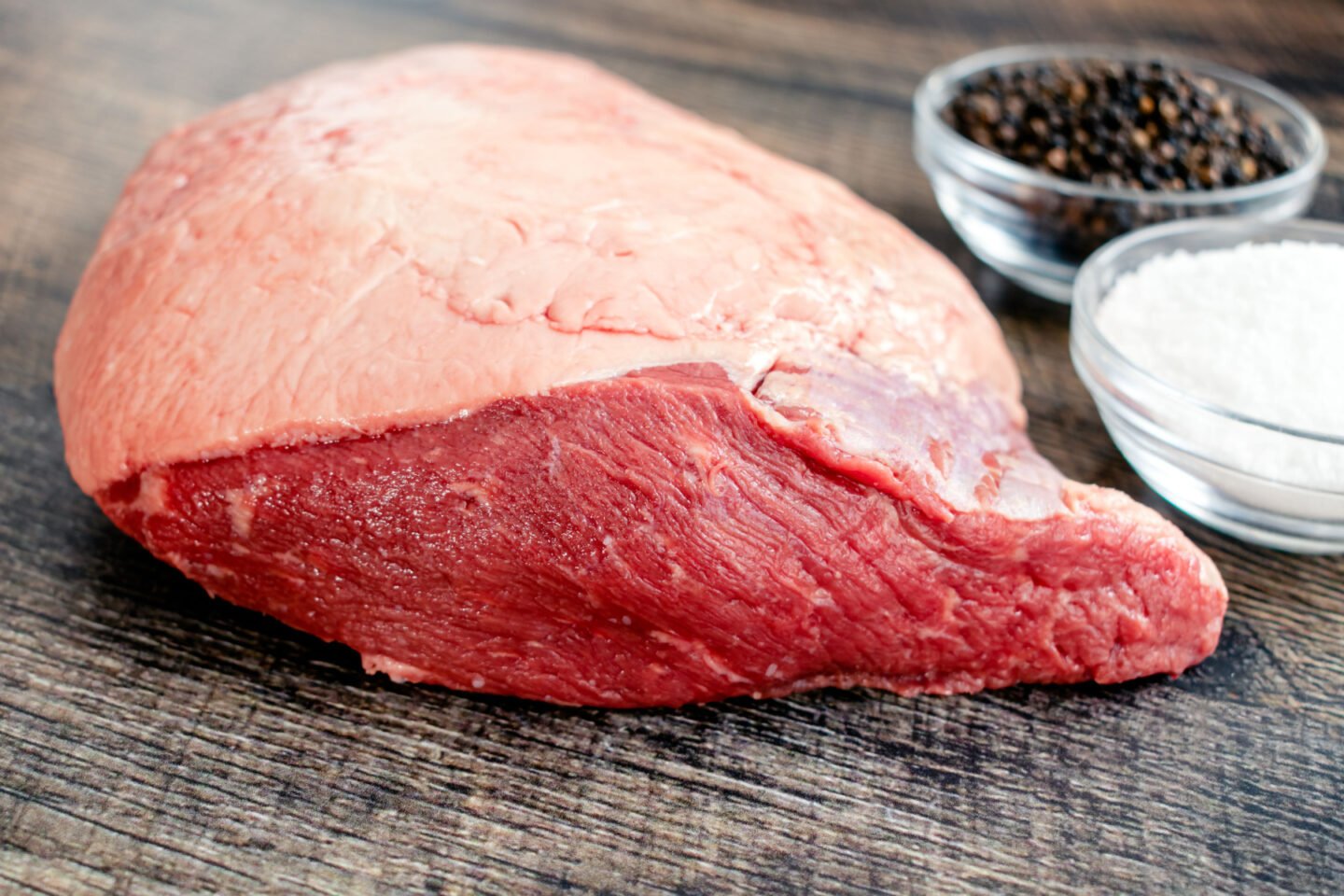
Different names: picanha, fat cap, rump cap, or top sirloin cap
Appearance: Long, with a thin layer of fat running down the whole length
Flavor: Juicy and fatty
Tenderness: Very tender when cooked and sliced properly
Cost: $6.99 per pound
Primal Cut: Loin
Most people haven’t heard the term coulotte steak before, but if you’ve ever eaten at a Brazilian steakhouse, you’ve probably tasted one. There, it’s probably listed as a picanha steak and is served cut into thin slices against the grain. This kind of presentation is crucial for the coulotte steak, as it is otherwise too tough to enjoy. However, when prepared properly, it is deliciously tender and juicy without all the fat of a ribeye.
Cube Steak
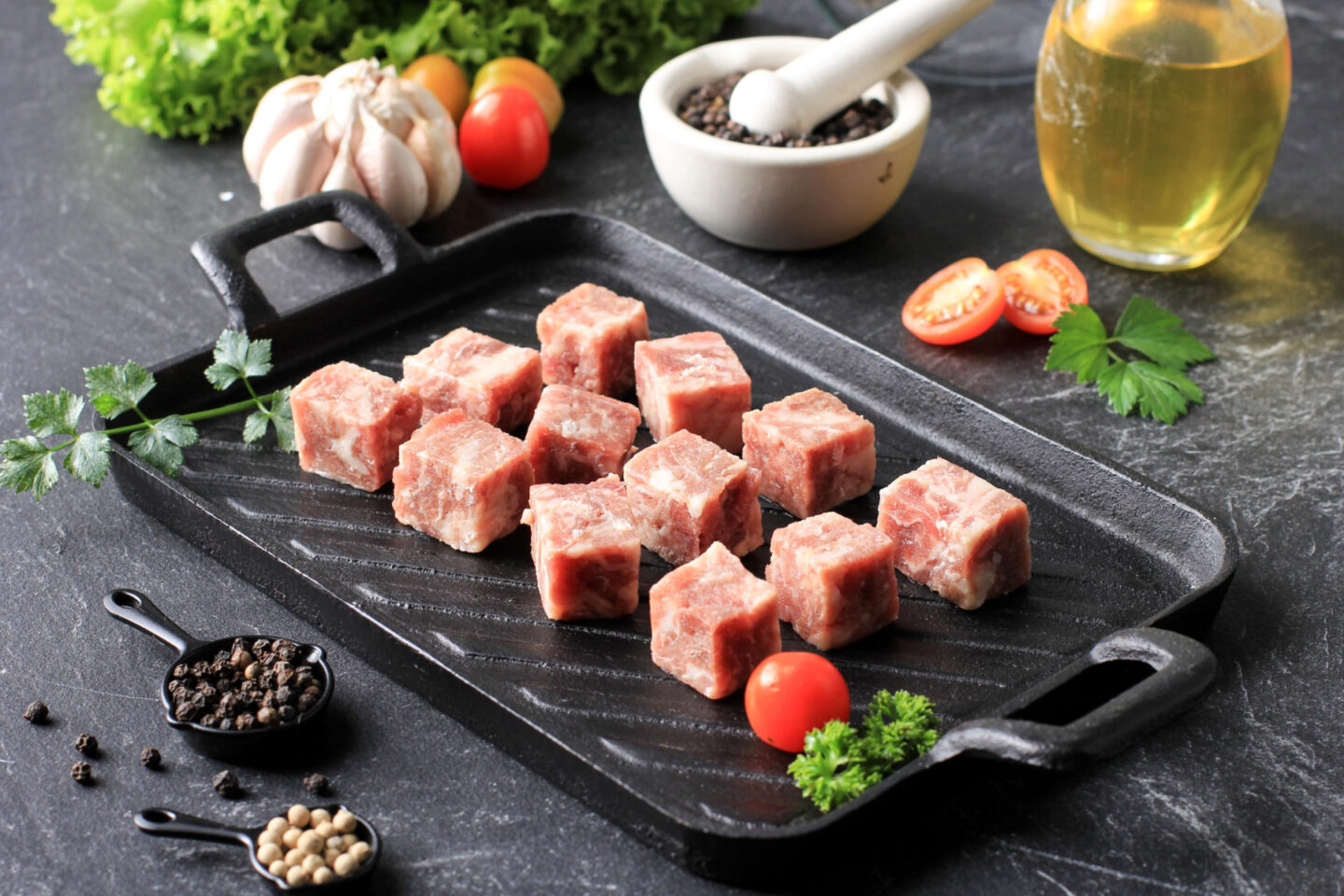
Different names: Chicken Fried Steak, Country Fried Steak, Milanesa, Minute Steak, Salisbury Steak, Swiss Steak
Appearance: A thin cut without much fat on it
Flavor: has a pronounced flavor, but needs added fat to shine
Tenderness: Very tough unless tenderized
Cost: $6.23 per pound
Primal Cut: Round
Cube steak is the prime budget cut in your supermarket, sold as wide, thin sheets of beef that are often pre-tenderized. While the cut itself is often too tough to enjoy on its own, the meat offers a nice chew once tenderized and is perfect for famous dishes like country-fried steak. While it isn’t the kind of cut you’re likely to find at a high-end steakhouse, cube steak is the perfect choice for certain dishes.
Picanha Steak
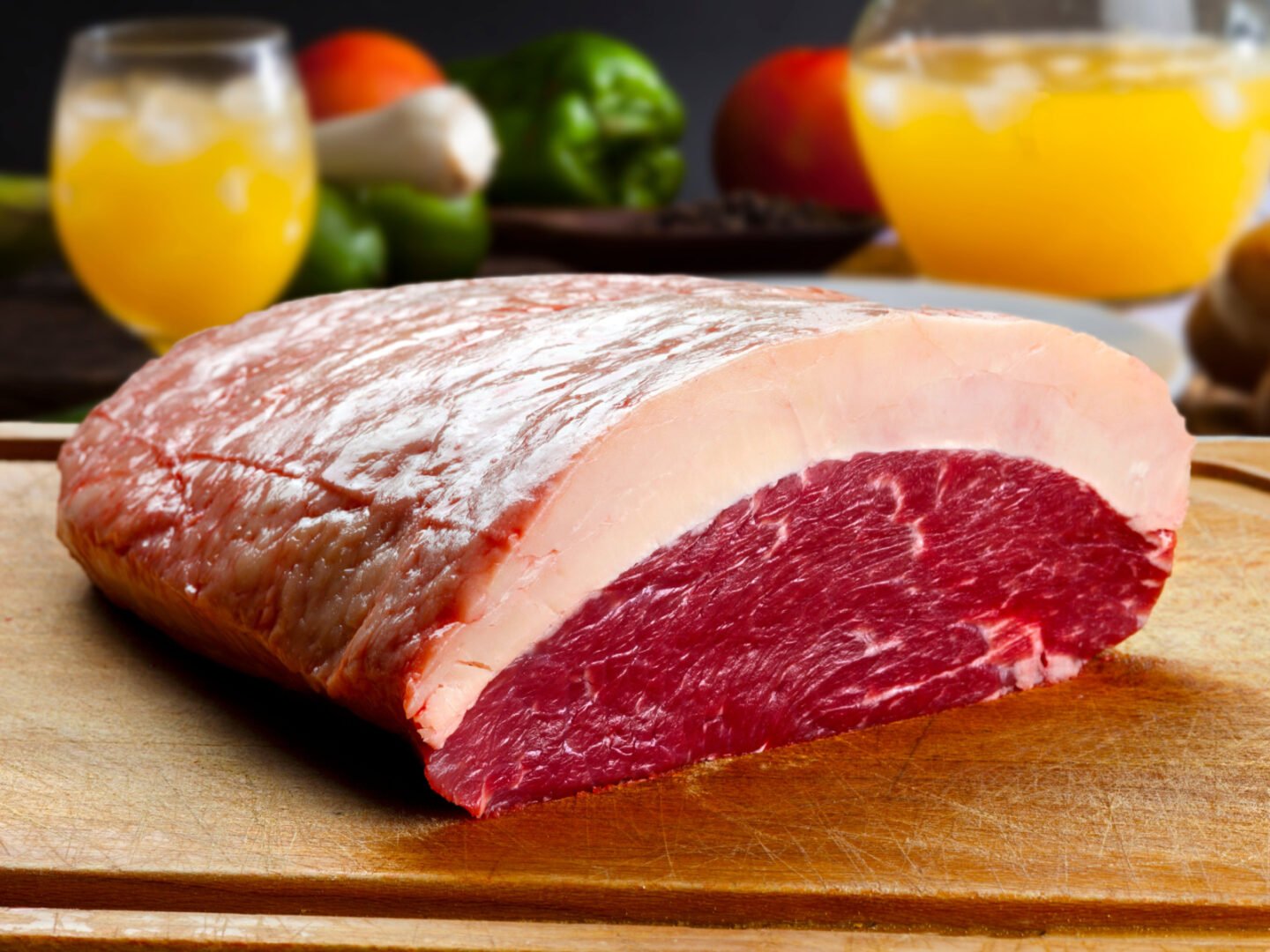
Different names: Sirloin cap, rump cap, culotte steak
Appearance: Varies, depending on the specific cut
Flavor: Can vary
Tenderness: Varies, but is usually a tough cut of meat that is sliced against the grain
Cost: varies
Primal Cut: Round or Loin
The term picanha steak actually doesn’t refer to a specific part of the cow, but a type of preparation that is specific to Brazilian cuisine. Picanha steaks are usually tough cuts that are seasoned with salt, char-roasted, and sliced against the grain to be enjoyed in thin strips. Many different cuts are used as picanha steaks, but the coulotte is the most common.
Beef Short Plate
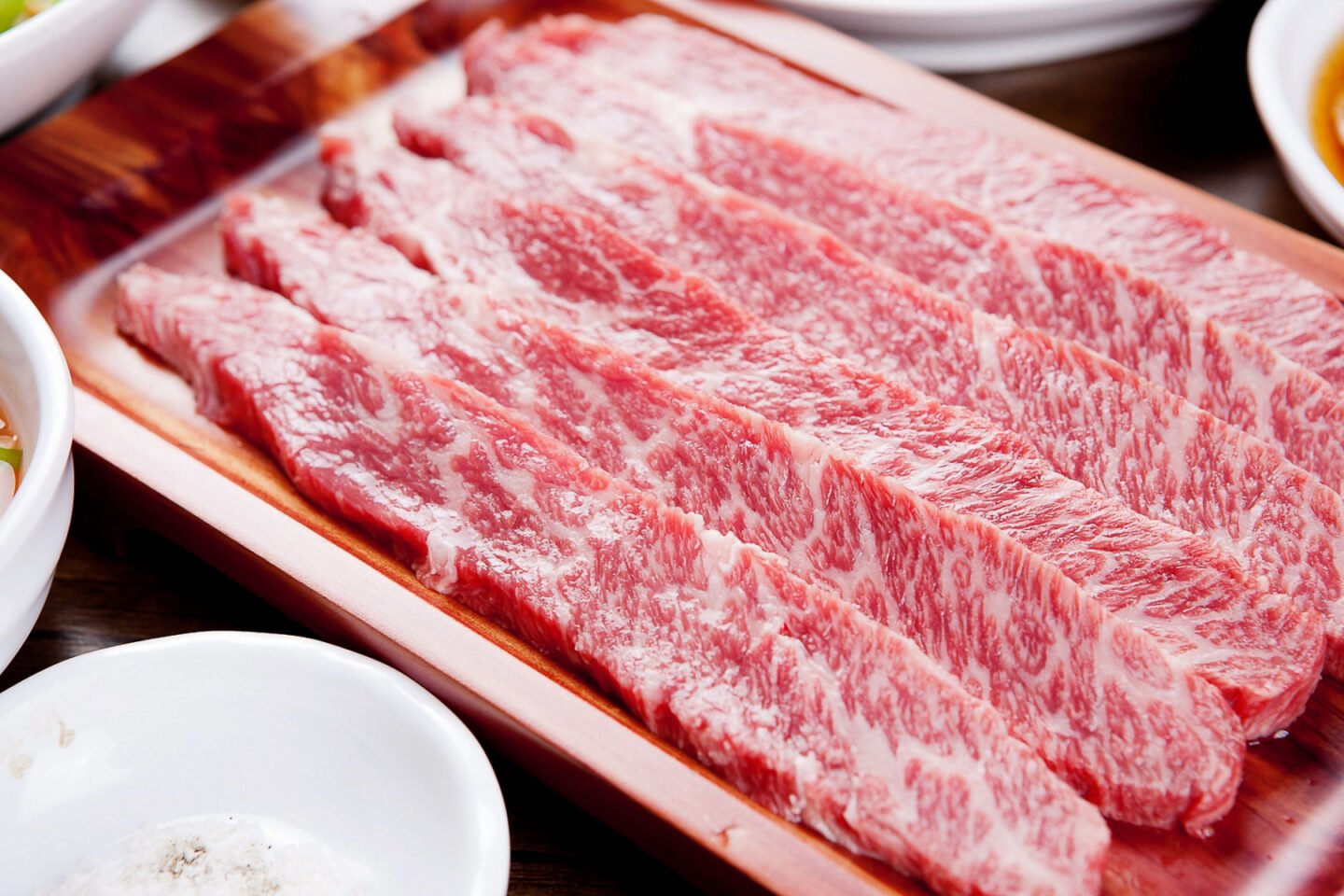
Different names: skirt steak, hanger steak, short ribs
Appearance: Large, wide slabs of beef with deep marbling
Flavor: Juicy and fatty
Tenderness: Fatty but tough
Cost: $6.23 per pound
Primal Cut: Short Plate
The beef short plate isn’t a cut you’re going to find at your local steakhouse but is something you might see in a butcher case. The reason is that it’s actually three cuts in one, comprising the skirt steak, hanger steak, and short ribs. This means it can be a good choice for those who want to do a bit of butchering themselves or for pitmasters who want to grill large slabs of meat all at once.
Eye of Round Steak
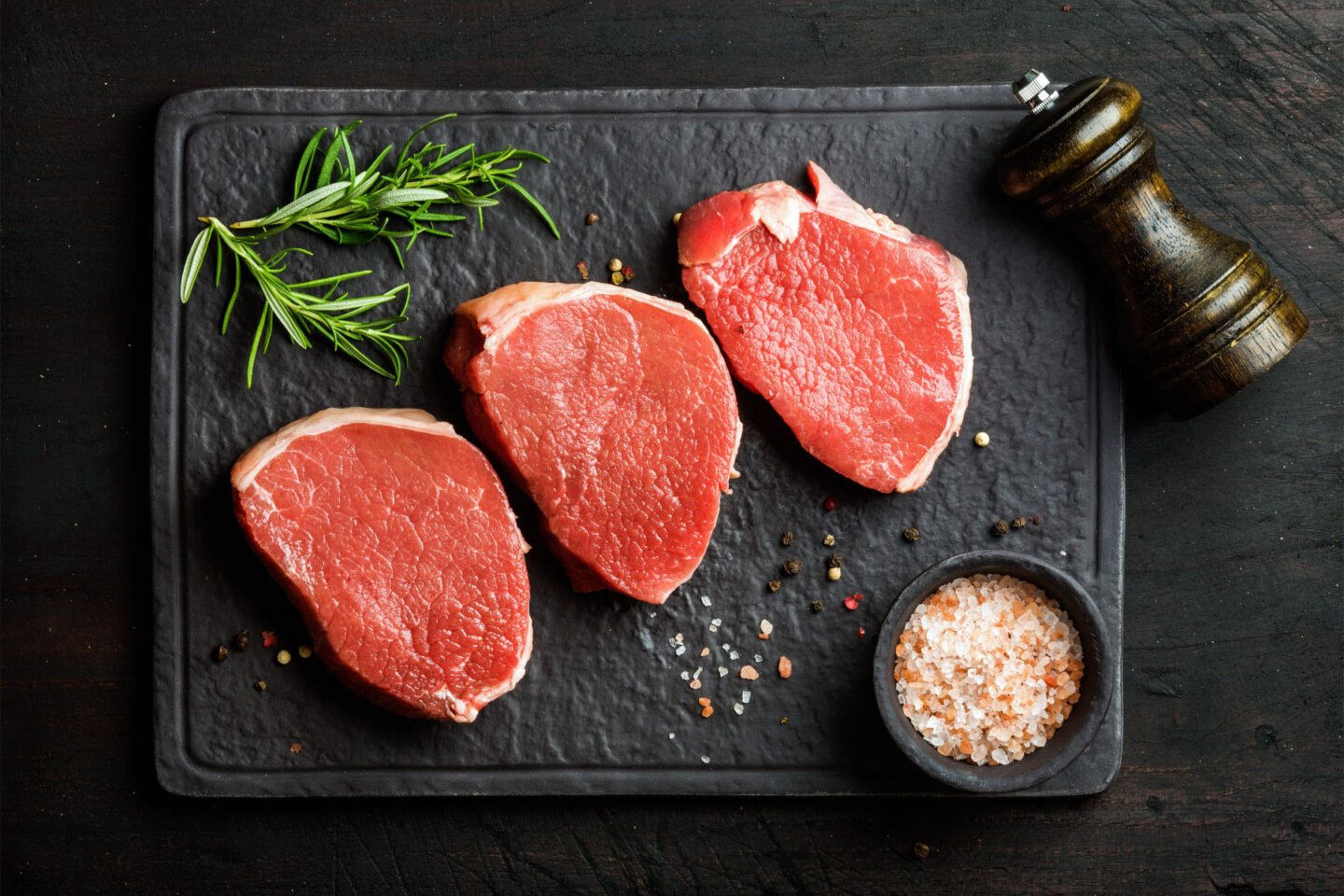
Different names: breakfast steak, wafer steak, sandwich steak, minute steak
Appearance: A round cut with little to no marbling
Flavor: Lean and relatively light in flavor
Tenderness: Tough and chewy
Cost: $6.99 per pound
Primal Cut: Round
Unless you have a specific reason to use eye of round in a recipe, it’s probably a cut you’d rather pass on. It doesn’t have much flavor and is tough and chewy, even when prepared with care. While it is inexpensive, you can usually find chuck steak for the same price but get more flavor out of it. Still, the eye of round can be enjoyed on sandwiches or as part of a steak and eggs breakfast.
Chuck Eye
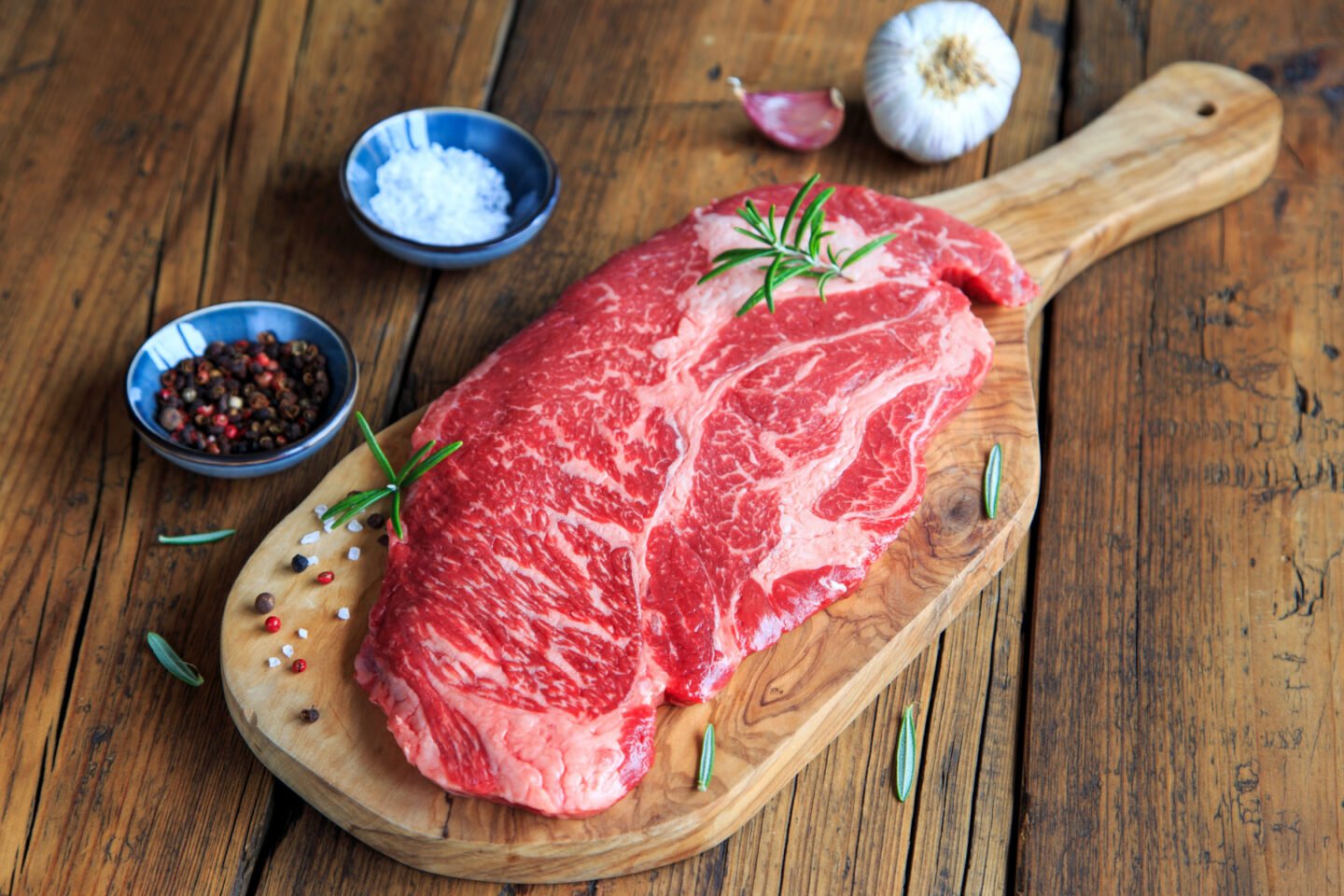
Different names: boneless chuck filet steak, boneless chuck slices, boneless steak bottom chuck
Appearance: medium-sized cut with lots of marbling
Flavor: rich and beefy
Tenderness: tender and juicy
Cost: $5.18 per pound
Primal Cut: Chuck
Think of the chuck eye as a poor man’s ribeye, with plenty of marbling and a big flavor that fits on any dinner plate. The key difference between the two is that the chuck eye is less expensive but slightly more temperamental on the grill. That makes it a good choice for those who have the experience to really make it shine.

Leave a Reply